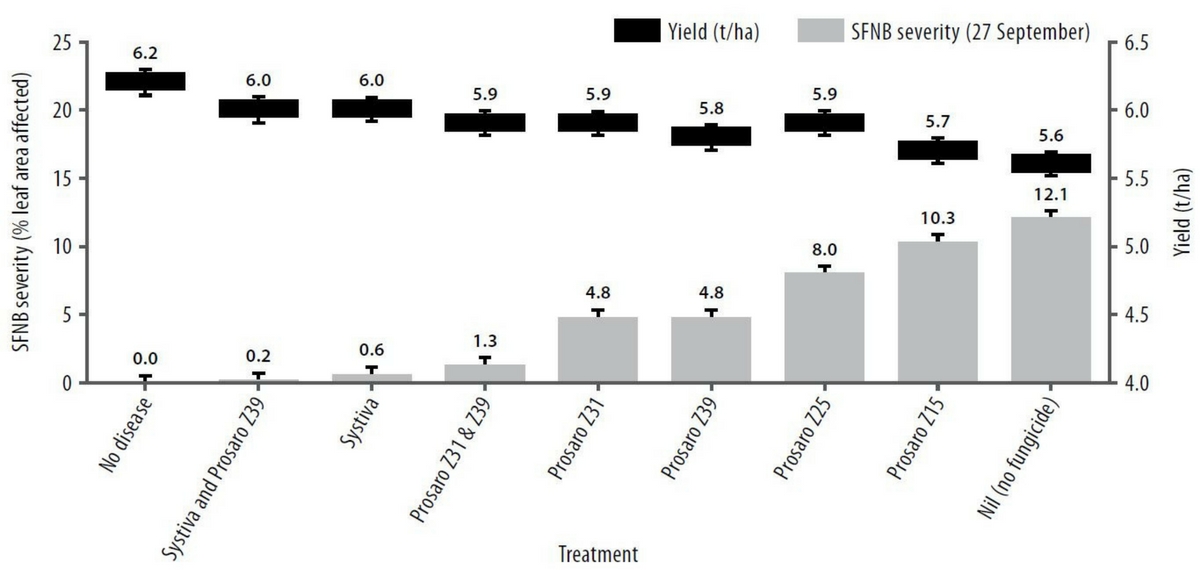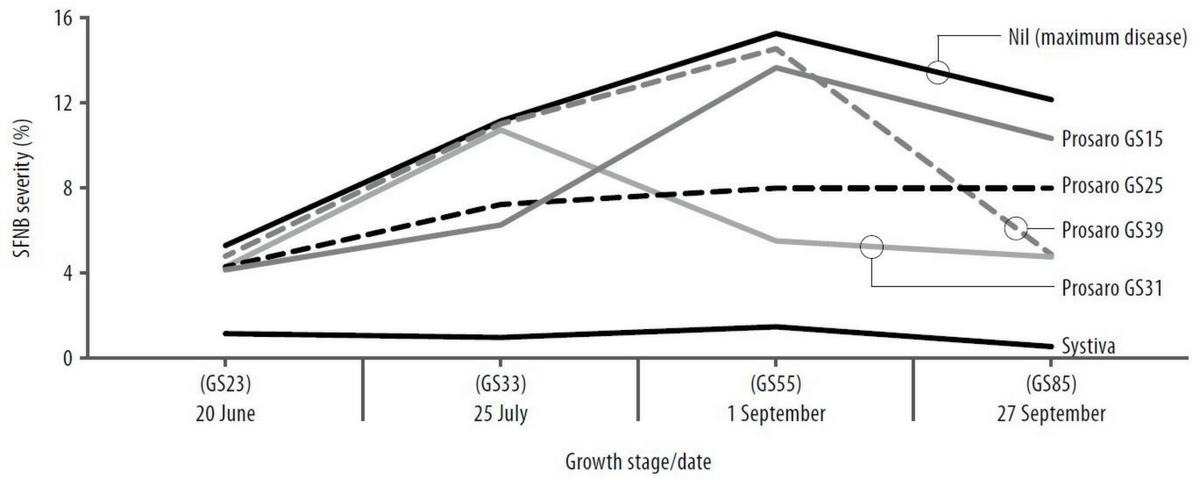Take home messages
- Spot form of net blotch caused significant grain yield loss (10%) at Curyo during 2017, but did not cause losses at Ultima, due to a drier spring and lower yield potential.
- Fungicides provided significant grain yield improvements at Curyo when applied using proactive approaches, such as seed applied Systiva® or foliar applied Prosaro® at GS25 or GS31. Fungicides did not provide a return at Ultima.
- Foliar fungicide at GS15 (seedling stage) did not provide significant grain yield improvements.
Background
Spot form of net blotch (SFNB) is a common stubble-borne foliar disease of barley in the Mallee. Its development is favoured by early sowing, cultivation of susceptible varieties, stubble retention practices and cool, wet climatic conditions. Previous collaborative research between Agriculture Victoria and BCG has shown that SFNB can cause up to 20% yield loss and significant reductions in grain plumpness during wet seasons (McLean and McColl 2015; McLean et al. 2017), however SFNB did not cause loss during dry seasons (McLean et al. 2016). The seed applied fungicide Systiva® (fluxapyroxad) or foliar applied fungicides Prosaro® (prothioconazole, tebuconazole) and propiconazole applied at both stem elongation (GS31) and flag emergence (GS39) have been shown to be very effective at controlling SFNB and minimising loss.
Aim
To identify effective fungicide application strategies for management of SFNB of barley in the Mallee.
Paddock details
| Locations: | Curyo and Ultima |
| Crop year rainfall: | Curyo: 297mm Ultima: 324mm |
| GSR (Apr-Oct): | Curyo: 215mm Ultima: 229mm |
| Soil type: | Curyo: Sandy clay loam Ultima: Clay loam |
Trial details
| Crop type: | Rosalind barley (SVS to SFNB) |
| Treatments: | Refer to Table 1. |
| Target plant density: | 130 plants/m² |
| Seeding equipment: | Knife points, press wheels, 30cm row spacing |
| Sowing date: | Curyo: 5 May 2017 Ultima: 9 May 2017 |
| Replicates: | Six |
| Harvest date: | Curyo: 10 November 2017 Ultima: 11 November 2017 |
Trial inputs
| Fertiliser: | Managed to maximise grain yield and quality according to soil test results |
| Herbicide: | Weeds were controlled according to best management practice |
| Insecticide: | Pests were controlled according to best management practice |
| Fungicide: | See Table 1. |
| Disease treatment: | 1kg of SFNB infected barley stubble applied to each barley plot |
Method
During 2017, two experiments were conducted, one each at Curyo and Ultima to further investigate the effectiveness of seed applied fungicide Systiva® and foliar applied fungicides Prosaro® for SFNB suppression and yield improvements. Foliar applied fungicides were tested at different timings and growth stages, with treatments based on those shown to be effective in previous research (McLean et al. 2016). Early season fungicide application at seedling (GS15) and tillering (GS25) stages were tested as these can be more practical in some situations, but there is little information on their effectiveness.
The trials consisted of the SFNB susceptible barley variety Rosalind, inoculated with approximately 1kg/plot of stubble naturally infected with SFNB. Six replicates of nine treatments (Table 1) were tested in a completely randomised block design. Wheat buffer plots were sown between each barley row to reduce disease influence from adjacent plots.
SFNB severity was determined by visually estimating percentage leaf area affected on four occasions: 20 June, 25 July, 1 September and 27 September. The first three assessments were estimates of SFNB in each plot. The last assessment was of each of the top three leaves of ten tillers. Grain yield was determined by measuring grain weight from each plot at harvest. Grain quality assessments of protein, retention, screenings and test weight were measured post-harvest.
Table 1. Treatment applied to Rosalind barley infected with SFNB at Curyo and Ultima during 2017.
Results and interpretation
Moderate SFNB developed at Curyo causing 0.6t/ha (10%) grain yield loss. Fungicides provided significant grain yield improvements when applied proactively and in a timely manner. The Systiva or Systiva plus Prosaro at GS39 treatments provided the greatest yield benefits of 0.4t/ha (6%) compared to the Nil treatment (Figure 1). The up-front seed treatment was very effective in keeping SFNB levels low during the wet winter and spring periods, resulting in little infection on the upper leaves at ripening (Figure 2).
Foliar fungicide application of Prosaro at GS25, GS31 or GS31 and GS39 were effective in reducing SFNB during the important grain development stages and provided 0.3t/ha (5%) yield improvement. Prosaro at GS39 provided some benefit, but was applied after SFNB had become established. Prosaro application at GS15 did not provide significant yield improvement compared to the Nil treatment, as SFNB was able to re-establish infection during the winter and spring months.
There was no grain quality loss due to good soil moisture at ripening. Average retention, screenings and grain weight were 87%, 2% and 67 kg/hL respectively.


Average grain yield was 3.2t/ha and maximum SFNB severity was 3.1% at ripening at Ultima. There was no grain yield or quality loss due to SFNB, due to dry spring conditions which restricted SFNB infection on the top three leaves. Grain quality measurements of 40%, 13% and 68kg/hL screenings, retention and grain weight were recorded respectively.
At Ultima, Systiva was the most effective treatment as it resulted in the low SFNB severity throughout the season. Prosaro at GS25, GS31 or GS31 and GS39 were also effective, providing significant reductions in SFNB severity during the grain development stages. Application of Prosaro at GS39 or GS15 were the least effective.
On-farm profitability
All fungicide treatments provided economic return on investment at Curyo, during 2017 (Table 2). Systiva provided the greatest return of $69/ha. Most other treatments also provided a significant economic benefit. Prosaro at GS15 was the least profitable and providing marginal return on investment.
There was no yield improvement from fungicide application at Ultima which resulted in a loss on investment where fungicides were applied (Table 2).
Table 2. Economic return of fungicide treatments for spot form of net blotch control at Curyo during 2017.
Based on barley grain price of $210/t, Prosaro @ $17/ha per application and Systiva @ $15/ha.
Commercial practice
Spot form of net blotch can be effectively controlled in susceptible barley varieties grown in the Mallee using a proactive approach that includes either Systiva® and/or foliar fungicide during late tillering (GS25) to early stem elongation (GS31) stages. Previous research has shown that propiconazole can be just as effective as Prosaro® which would be a good low cost option for the Mallee. A follow up application of foliar fungicide may be required at flag emergence (GS39) during seasons with a wet spring. This strategy will provide benefit in high risk situations where a susceptible variety is sown into infected barley residue from the last two seasons. It will also provide control of other important foliar diseases such as net form of net blotch and scald which are also common in the Mallee.
Grain yield and quality benefits will depend on whether late winter and spring rainfall occurs. Application of fungicide is unlikely to provide benefit in the Mallee during seasons of below average rainfall and yield and where there is no barley stubble present in the paddock. It is important to rotate fungicides and use products with different active ingredients where possible to reduce the possibility of resistance developing.
References
Acknowledgements
The authors acknowledge the investment and support from the Grains Research and Development Corporation and Agriculture Victoria (DAV000129). We also thank the cereal pathology group at Agriculture Victoria, Horsham and technical group at Birchip Cropping Group for technical support.


